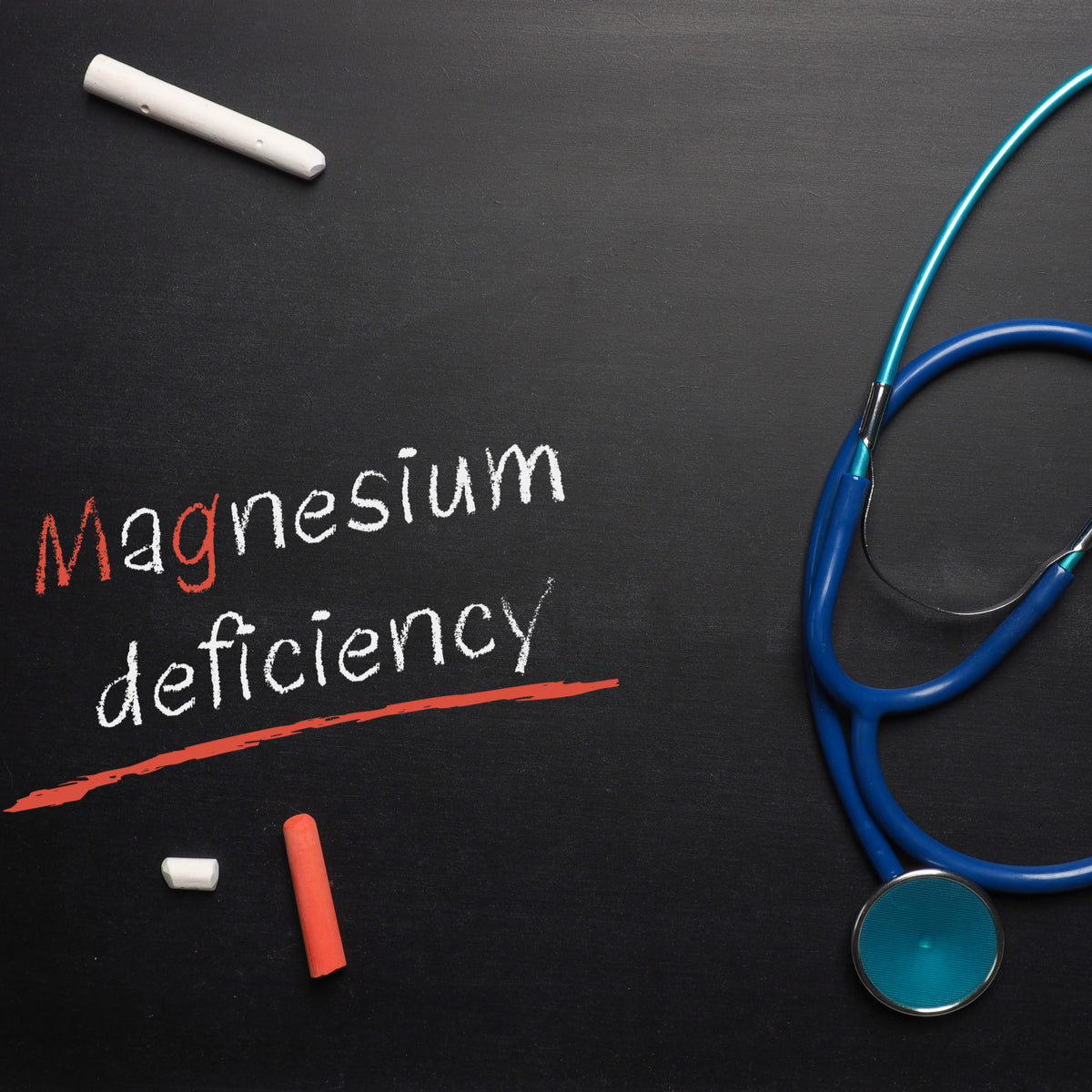Magnesium deficiency isn’t the most common mineral deficiency in the U.S., but it may be more common than people realize. As many as half of US adults may be low in magnesium, which can cause magnesium deficiency symptoms and increase health risks.
There are dietary sources of magnesium and other ways to get this essential mineral. For different types of magnesium, you might also look at supplements. A magnesium patch may be the answer for you, especially if you need supporting nutrients or have specific health goals that the patch focuses on. PatchAid Magnesium Patches are carefully formulated to provide types of magnesium in high amounts, along with other nutritional compounds.
As always if you have health concerns or are considering taking a nutritional supplement or using a patch, be sure to talk to your healthcare provider.
Magnesium Deficiency Symptoms
Magnesium is an essential mineral that you need to get from your diet or a supplement, and that you need to be healthy. It’s the fourth most abundant mineral in the body. Calcium, phosphorus, potassium, and sodium are also in high amounts. Magnesium is a crucial mineral in the structure of bones and cell membranes. It also has these roles.
- Plays a part in energy production during carbohydrate and fat metabolism.
- Allows the synthesis of genetic material and proteins for reproduction and growth.
- Is needed for cell signaling processes.
- Helps with nerve impulses, muscle contraction, and heart rhythm.
So how might you know if you have a magnesium deficiency? These are some magnesium deficiency symptoms.
- Muscle spasms and cramps
- Low serum potassium and calcium
- Sodium retention and bloating
- Nausea and vomiting
- Mood changes
Long-term, there are some other possible effects of not having enough magnesium. Being low in magnesium can increase the risk of having high blood pressure, heart disease, poor blood sugar control, or migraines. It’s also possible that low magnesium status is a risk factor for Alzheimer’s disease. Since magnesium is a component of bone mineral, low magnesium status over time can lead to osteoporosis and an increased risk for bone fractures.
It’s possible to have magnesium deficiency without symptoms. If you think you might be low in magnesium, be sure to express your concerns to your healthcare provider.
Magnesium Deficiency Causes
It’s important to know that you can have a magnesium deficiency without it being severe. In fact, severe magnesium deficiency is rare. That’s because it’s in a lot of foods. Also, your kidneys can limit the excretion of magnesium to save it in the body when intake is low. Still, low-level magnesium deficiency can be present.
These are some possible magnesium deficiency causes.
- Kidney disorders, which can lead to excess release of magnesium from the body. Diabetes and certain medications can contribute to this.
- Gastrointestinal disorders, such as Crohn’s disease, diarrhea, celiac disease, and other conditions related to malabsorption or depletion.
- Endocrine and metabolic conditions, such as diabetes and parathyroid disorders.
If you have any risk factors for magnesium deficiency, contact your healthcare provider. It’s a good idea to address underlying magnesium deficiency causes as well as the actual deficiency, as well as to discuss any medications that may be related to magnesium status. Your healthcare provider might support you using a magnesium patch to get more magnesium and some other nutrients or nutritional components that can be related to the causes of your magnesium deficiency.
Testing for Magnesium Deficiency
It’s easy to assess your body’s status of many vitamins and minerals. That’s not the case for magnesium. There are a couple of reasons for this. One is that a blood test may not be completely indicative of how the magnesium status in your body truly is. You can do a dietary assessment of magnesium intake, but it’s not always very accurate.
Another reason why it’s hard to assess magnesium deficiency is that nutritionists don’t know exactly what “optimal” status means for magnesium! You may have enough magnesium stores to prevent severe magnesium deficiency symptoms, but that amount may not be enough to promote optimal health.
The estimated average requirement (EAR) is the amount of a nutrient that is adequate for about half the population. It seems that the average magnesium intake is close to that amount. That means that about half the population may be low in magnesium.
What Can Magnesium Do for You?
Do you have magnesium deficiency symptoms? Are you thinking about using magnesium for anxiety? What can magnesium do for you?
What magnesium can do for you depends on your own individual situation and the magnesium deficiency causes. Magnesium has certain critical roles in the body. Here are some possible benefits of maintaining a normal magnesium status in the body.*
- Helps to support healthy bone metabolism.
- Helps to maintain normal nerve and muscle function.
- Helps to support brain health.
- Helps to promote normal sleep cycles and mood.
*The Food and Drug Administration has not evaluated these statements. The Vitamin D3/Calcium Vitamin Patch by PatchAid is not intended to diagnose, treat, cure or prevent any disease. Anyone with a medical condition should seek the advice of a licensed medical practitioner. Individual results may vary.
Natural Ways to Get More Magnesium
Now, how can you get more magnesium if you think you have a magnesium deficiency? One way is to look for foods that are naturally high in magnesium. Green vegetables, beans, nuts, and other plant-based, whole foods tend to be highest in magnesium because magnesium is needed for energy production by plants, but a wide variety of foods have magnesium. These can include the following.
- Nuts, with Brazil nuts being highest in magnesium. Hazelnuts, almonds, and pistachios also have magnesium.
- Peanuts and peanut butter.
- Beans, lentils, split peas, and lima beans.
- Whole grains, such as brown rice, and especially those with wheat bran or oat bran, such as shredded wheat, oat bran cereal, and whole wheat bread.
- Leafy green vegetables, such as swiss chard.
- Meat and fish.
- Avocados.
- Milk.
- Bananas.
As you can see, it would be hard to avoid all food sources of magnesium!
Along with checking for foods that are high in magnesium, you can be sure to get enough of other nutrients. That’s because a deficiency in some vitamins and minerals can cause a magnesium deficiency. In particular, it’s good to be sure that you have adequate status of these nutrients to make sure that they’re not causing a magnesium deficiency.
- Vitamin D. Having enough vitamin D may allow for better absorption of magnesium, similar to the way that vitamin D sufficiency supports better calcium absorption.
- Protein. This isn’t a problem for most people, but it can be of concern for certain groups, such as bariatric surgery patients who are having trouble getting enough protein.
On the other hand, you don’t want to have too much of certain nutrients. For example, excessive intakes of zinc can lead to a decrease in magnesium absorption in the body. Similarly, it’s possible that a sudden and dramatic increase in fiber intake can impair magnesium status.
Different Types of Magnesium
Magnesium supplements have some forms of magnesium that can help improve your status. Oral supplements can help, but they can also have side effects. The most common side effects are gastrointestinal side effects, such as diarrhea, nausea, and vomiting.
Magnesium pills can also interfere with certain medications or their effects. It’s best to ask your doctor before starting a magnesium supplement just to be on the safe side. You might also want to ask about a magnesium patch instead of a pill or chewable oral supplement.
Patches for Magnesium Deficiency
As you investigate how to correct magnesium deficiency, you might want to consider a magnesium patch. PatchAid has many patches that include magnesium as part of their lineup of vitamins, minerals, and other components. The magnesium patch that you choose can depend on how much magnesium it has, as well as its other ingredients and how they fit into your lifestyle.
These are some of the PatchAid Magnesium Patches that also contain other nutrients and ingredients.
Most magnesium is stored in the bones, and this patch includes 350 mg of magnesium, or 88% of the daily value. It also has calcium and vitamin D3, which is the active form of vitamin D. These nutrients support bone health, not to mention nerve function, brain health and immune function.
A well-known magnesium deficiency symptom is muscle cramping, which can get in the way of sleep. Magnesium is needed for proper muscle relaxation! This patch has 300 mg of magnesium, or 75% of the daily value. It also has melatonin, which is a hormone that is part of a normal sleep-wake cycle. 5-HTP and L-tryptophan work together in the brain to allow for normal relaxation, and valerian root is a long-used herbal ingredient.
The immune system depends on an adequate supply of magnesium, and this patch has 100 mg of magnesium, or 25% of the daily value. It also provides essential nutrients such as zinc and vitamins C, E, and B6 to support immune health. Green tea leaf, licorice root extract, garlic extract, and antioxidants are some of the other compounds in this patch.
This patch has 300 mg of magnesium, or 75% of the daily value. It also has calcium and vitamin D3, as well as vitamin K2. Vitamin K is needed for proper bone metabolism.
You definitely don’t want to be low in magnesium if you are prone to migraines. This patch contains 250 mg of magnesium or 60% of the daily value for magnesium. In addition, it has riboflavin, folate, vitamin B6, vitamin B12, and vitamin D3. Other ingredients in this patch include coenzyme Q10, which is a well-known antioxidant, and ashwagandha extract, which has been used for centuries.
It’s easy to use a magnesium patch. Just peel off the backing and apply the sticky side to a clean, smooth, dry area of skin, preferably without hair. While the patch is on, you can do anything from sleep to exercise to take a shower. The patch is flexible and designed to stick through a shower or a swim workout! Leave the patch on for up to 8 hours, then take it off. You can use the next patch the next day.
Lots of PatchAid customers use multiple patches at once. That’s what we intended! We’ve designed PatchAid patches to be used together so you can get the nutrients you are looking for in any combination you want. Just work with your doctor to choose the best patches for your nutritional status and health goals.
Magnesium deficiency isn’t always obvious, but maintaining optimal status can enable your body to function properly. Metabolism, growth, and brain, muscle, and heart health all depend on magnesium, and magnesium deficiency symptoms can be related to those functions. Different forms of magnesium have their own pros and cons.
A magnesium patch from PatchAid is easy to use, avoids side effects associated with oral supplements, and comes with supporting nutrients depending on your own health concerns. Just talk to your healthcare provider before taking any supplement or when you have questions about your health.







